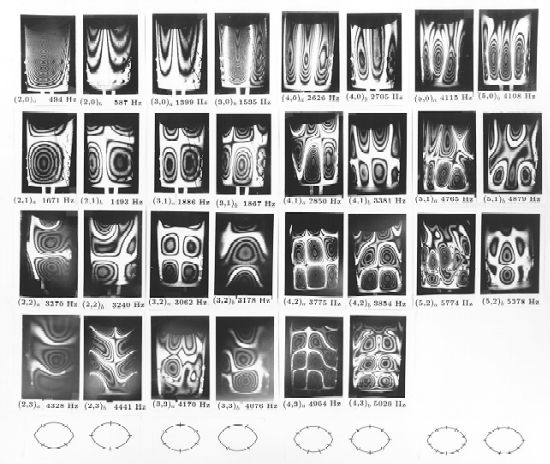This is from http://www.acoustics.org/press/133rd/2pmu1.html
Thomas D. Rossing
Acoustics of Eastern and Western Bells, Old and New
Acoustical Society of America
133rd Meeting Lay Language Papers
Popular version of paper 2pMU1
Presented Tuesday afternoon, June 17, 1997
133rd ASA/NOISE-CON 97 Meeting, State College, Pennsylvania
Thomas D Rossing,
Physics Department, Northern Illinois University
DeKalb, IL 60115
Bells have been an important part of almost every culture in history. Bells have served as musical instruments, as signaling devices, in religious worship, to communicate, and to sound warnings.
Many ancient Chinese bells, some more than 3000 years old, remain from the time of the Shang and Zhou dynasties. Most of these bells, being oval or almond-shaped, sound two distinctly different notes, depending upon where they are struck. Although small ornamental bells may have exited in India, Assyria, and Egypt as early as 2000 B.C., the bells that remain from these early civilizations do not compare to the ancient Chinese bells in size or in quality.
The art of designing and casting ancient bells reached its peak in China during the Western Zhou (1122-771 B.C.) and Eastern Zhou (770-249 B.C.) dynasties. Most musical bells were manufactured in scaled sets or chimes. Chimes of bells were frequently buried in the tombs of royalty and noblemen, and that is how large numbers of ancient bells have been well preserved through the ages. The most remarkable set of bells discovered to date is the 65-bell set discovered in the tomb of Zeng Hou Yi (Marquis Yi of Zeng) in 1987. These richly-inscribed bells survived in excellent condition since about 433 B.C. due to the tomb filling with water.
Holographic interferograms showing how a Chinese two-tone bell vibrates are shown below. Each mode of vibration in a circular bell corresponds to two modes of vibration in a two-tone bell. Striking the bell near the center of its broad face excites the (2,0)a and other modes which have maximum amplitude there and gives one tone; striking it about one half the way toward the xian or spine, excites the (2,0)b and other modes with maximum amplitude off the center and gives a higher tone. The interval between the two tones usually ranges from a major third to a minor third on the Western scale.
 |
After the 3rd century A.D., round temple bells gradually replaced two-tone bells. Many cities placed large bells in towers to announce the time of day. The most famous temple bell in Korea is the magnificent King Songdok bell, cast in 771 A.D. during the Silla dynasty. Standing 3.66 m high, it has a mass of nearly 20,000 kg. The largest known Chinese bell, standing over 4.5 m high, was cast in the 15th century during the reign of the Ming emperor Yongle.
Bells developed as Western musical instruments around the 17th century when bell founders learned how to tune their partials harmonically. The founders in the Low Countries, especially the Hemony brothers (Francois and Pieter) and Jacob van Eyck, took the lead in tuning bells, and many of their fine bells are found in carillons today.
Bell tuning standards and practices changed very little from the time of the Hemony's until just a few years ago, when a team of scientists and bell founders in The Netherlands developed a new type of carillon bell in which the dominating minor third partial of the traditional bell is replaced by a major third partial. Now it is possible to build carillons of either minor-third or major-third bells (or even both together).
Handbells date back at least several centuries B.C., although tuned handbells of the present-day type were developed in England in the 19th century. In recent years, handbell choirs have become popular in schools and churches, some 40,000 handbells choirs have been reported in the United States alone. Tuned handbells are generally made of cast bronze, which has been the traditional bell material for many centuries.
Demand for handbells of lower and lower pitches has led to the development of bass bells as low as G0 (fundamental frequency of 24.5 Hz). Bronze handbells tuned to this pitch radiate inefficiently, however, since the vibrational waves travel considerably slower in the bells than they do in the air nearby, thus creating a sort of acoustical "short circuit." In order to obtain a higher radiation efficiency and thereby enhance the sound of bass bells, the Malmark Company has created a new bell design using aluminum rather than bronze. These new bells are larger in diameter and radiate much more efficiently than bronze bells, yet they are lighter in weight. In our laboratory at Northern Illinois University, we have studied the modes of vibration of these bells (using holographic interferometry) and also the sound radiation.
These are but a few examples of how scientists and bell designers have teamed together to further improve one of mankind's oldest musical instruments.